Operations
Top Operations Consultation in Global Business Services
In today’s interconnected world, Operations in Global Business Services (GBS) are pivotal for driving efficiency and innovation across organisations. Leveraging a unified service delivery model, GBS enhances operational excellence by streamlining processes, reducing costs, and fostering agility in your shared services and service delivery model.
Our consultancy specialises in optimising GBS frameworks, enabling you to harness the full potential of your global operations. By integrating advanced technologies and data-driven insights, we help businesses adapt to market dynamics, enhance customer-centric experiences, and achieve sustainable growth. Partner with us to transform your operational strategies and unlock new avenues for success in the global marketplace.
Operations in Global Business Services
Our Operation GBS Services are designed to empower businesses to achieve operational excellence in a globally competitive environment. By focusing on service delivery optimisation, technology integration, change management, performance measurement, risk management, and customised solutions, we enable you to thrive.
Partner with us to transform your operational strategies and unlock the full potential of your global business services provided to your business units. Together, we can navigate the complexities of the global marketplace and achieve sustainable success.
At our consultancy, we pride ourselves on offering comprehensive Operation Global Business Services (GBS) that cater to the unique needs of businesses in an increasingly competitive landscape. Our services are designed to streamline operations, enhance productivity, and drive sustainable growth, ensuring that you can focus on your core business objectives.
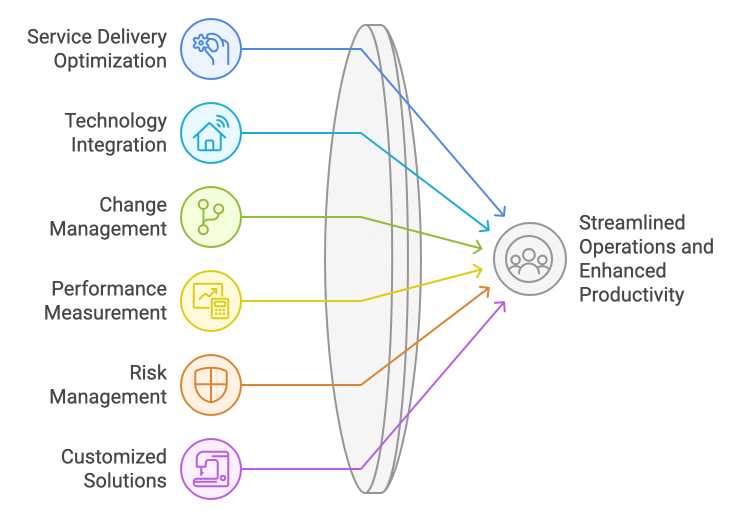
A. Service Delivery Optimisation
We understand that an efficient service delivery model is crucial for operational success. Our experts analyse existing end-to-end processes to identify bottlenecks and inefficiencies. Through the implementation of best practices and industry benchmarks, we help organisations transition to a more streamlined service delivery approach. This includes automating routine tasks, adopting agile methodologies, and optimising resource allocation to maximise performance.

1. Process Assessment and Mapping
- Conduct a Comprehensive Review: Begin by gathering data on current service delivery processes. This includes workflow documentation, performance metrics, and feedback from your stakeholders.
- Map Existing Processes: Create visual representations of your current workflows to identify how tasks are completed, who is involved, and where delays or inefficiencies occur.
2. Identify Bottlenecks and Inefficiencies
- Analyse Process Flows: Review the mapped processes to pinpoint areas where delays, redundancies, or errors frequently occur. This may involve looking at cycle times, error rates, and resource utilisation.
- Engage Stakeholders: Conduct interviews or workshops with your employees involved in the processes to gather insights on pain points and obstacles they face.
3. Benchmark Against Best Practices
- Research Industry Standards: Compare your processes against industry best practices and benchmarks. Identify areas where your organisation falls short and opportunities for improvement.
- Leverage Expert Insights: Collaborate with industry experts or consultants to gain insights into successful service delivery models used by leading organisations.
4. Design and Implement Streamlined Processes
- Redesign Workflows: Based on the analysis, redesign workflows to eliminate bottlenecks and inefficiencies. This may involve reassigning tasks, consolidating processes, or removing unnecessary steps.
- Implement Automation: Identify routine and repetitive tasks that can be automated using technology. Implement Robotic Process Automation (RPA) or other automation tools to enhance efficiency.
5. Adopt Agile Methodologies
- Foster an Agile Culture: Encourage teams to embrace agile methodologies, focusing on flexibility and responsiveness to change. Implement iterative processes that allow for quick adjustments based on feedback.
- Train Teams: Provide training on agile practices, such as Scrum or Kanban, to empower teams to adopt these methodologies effectively.
6. Optimise Resource Allocation
- Evaluate Resource Utilisation: Assess how resources (human, financial, and technological) are currently allocated across service delivery processes.
- Reallocate Resources: Optimise resource distribution based on process needs and performance metrics, ensuring that teams are adequately equipped to meet service demands.
7. Monitor Performance and Continuous Improvement
- Establish KPIs: Define key performance indicators (KPIs) to measure the effectiveness of the optimised service delivery processes. Monitor metrics such as cycle times, customer satisfaction, and cost savings.
- Implement a Feedback Loop: Create mechanisms for continuous feedback from stakeholders to identify areas for further improvement. Regularly review performance data and make necessary adjustments to processes.
8. Communicate and Train
- Communicate Changes: Clearly communicate the changes made to service delivery processes to all stakeholders. Ensure that everyone understands the new workflows and your roles within them.
- Provide Ongoing Training: Offer training sessions to support employees in adapting to new processes and technologies, fostering a culture of continuous learning.
We can help you achieve significant improvements in service delivery optimisation within your Global Business Services. This strategic approach not only enhances operational efficiency but also position your business to respond effectively to changing market demands and customer expectations.
B. Technology Integration
In the digital age, the right technology can make all the difference. Our team specialises in integrating advanced technologies such as Artificial Intelligence (AI), Robotic Process Automation (RPA), and data analytics into GBS operations. By leveraging these tools, we empower you to enhance decision-making processes, improve service quality, and achieve greater operational agility. Our technology integration services ensure that your operations are not only efficient but also future-ready.
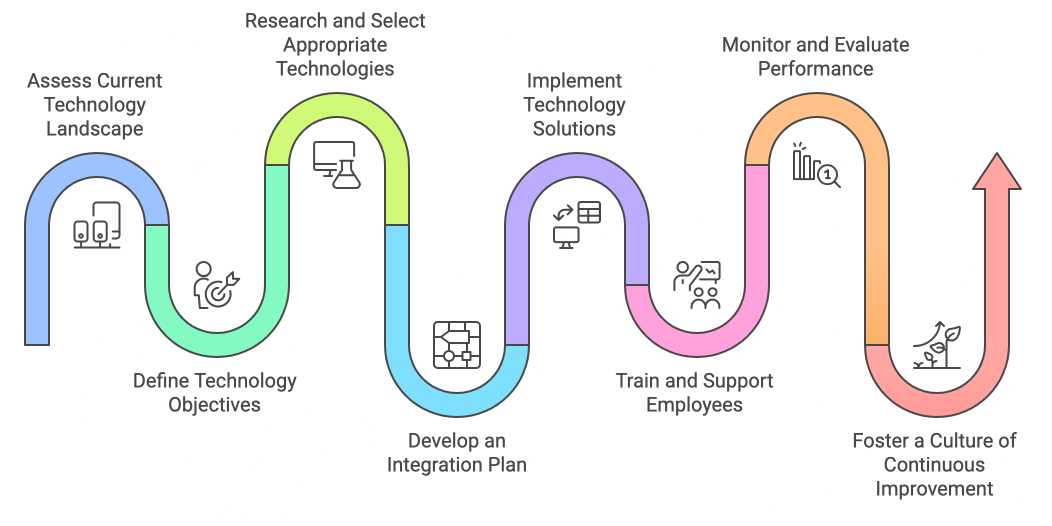
1. Assess Current Technology Landscape
- Conduct a Technology Audit: Evaluate your existing technology infrastructure, tools, and systems currently in use. Identify strengths, weaknesses, and any gaps that need to be addressed.
- Gather Stakeholder Input: Engage with your teams across the organisation to understand your experiences with current technologies and gather feedback on your needs and challenges.
2. Define Technology Objectives
- Establish Clear Goals: Determine the specific objectives for your technology integration, such as improving process efficiency, enhancing data analytics capabilities, or automating routine tasks.
- Align with Business Strategy: Ensure that your technology objectives align with the overall business strategy and operational goals of the organisation.
3. Research and Select Appropriate Technologies
- Identify Suitable Solutions: Research various technologies that can meet your defined objectives. This may include Robotic Process Automation (RPA), Artificial Intelligence (AI), cloud computing, and data analytics tools.
- Evaluate Vendors: Compare different technology vendors based on functionality, scalability, cost, and support services. Consider conducting demonstrations or pilot programs for you to assess your capabilities.
4. Develop an Integration Plan
- Create a Roadmap: Develop a detailed integration plan for you outlining the timeline, resources, and steps required for successful implementation. Include milestones and deliverables to track progress.
- Allocate Resources: Ensure that adequate resources—both financial and human—are allocated for the integration process, including budget for technology acquisition and training.
5. Implement Technology Solutions
- Pilot Programs: Start with pilot programs to test the selected technologies in a controlled environment. Gather feedback and address any issues before full-scale implementation.
- Full-Scale Rollout: Once the pilot is successful, proceed with the full-scale implementation of the technology solutions across your relevant GBS functions.
6. Train and Support Employees
- Develop Training Programs: Create training resources and workshops for your employees to familiarise them with the new technologies and how to leverage them effectively in your roles.
- Provide Ongoing Support: Establish your support channels, such as help desks or user forums, to assist employees with any questions or challenges they may encounter during the transition.
7. Monitor and Evaluate Performance
- Establish Metrics for Success: Define your key performance indicators (KPIs) to evaluate the effectiveness of the integrated technologies. This may include metrics related to productivity, accuracy, and user satisfaction.
- Conduct Regular Reviews: Regularly assess the performance of your technology solutions against the established metrics. Use this data to identify areas for improvement and optimisation.
8. Foster a Culture of Continuous Improvement
- Encourage Feedback: Create a culture that encourages your employees to provide feedback on the technology and its impact on your work processes. Use your feedback to inform future improvements.
- Stay Updated on Technological Advances: Keep abreast of emerging technologies and industry trends that could further enhance your GBS operations. Be open to adopting new solutions as needed.
Let us help you successfully integrate technology into GBS using our structured approach to optimise your operations, enhance service quality, and maintain your competitive edge in the global marketplace.
C. Change Management
Transitioning to a GBS model often involves significant changes in organisational structure and culture. Our change management consultants work closely with your teams to facilitate smooth transitions, minimising resistance and maximising engagement. We provide tailored training programs, communication strategies, and stakeholder engagement plans to ensure that your employees are well-equipped to embrace the new operational paradigm.
Implementing change within Global Business Services (GBS) requires a strategic approach to ensure that your transitions are smooth and employees are engaged throughout the process. Here are the key steps to effectively manage change in GBS.
We’ll help you to define and refine your vision and objectives:
- Establish a Clear Vision: Articulate a compelling vision for your change that aligns with your organisation’s overall strategy. This vision should outline the desired outcomes and benefits of the change initiative.
- Set Specific Objectives: Define measurable objectives that will guide your change process and provide a framework for your success.
Transitioning to a Global Business Services (GBS) model often involves significant organisational changes, which can create challenges if not managed properly. Effective change management is crucial for ensuring a smooth and successful transformation.
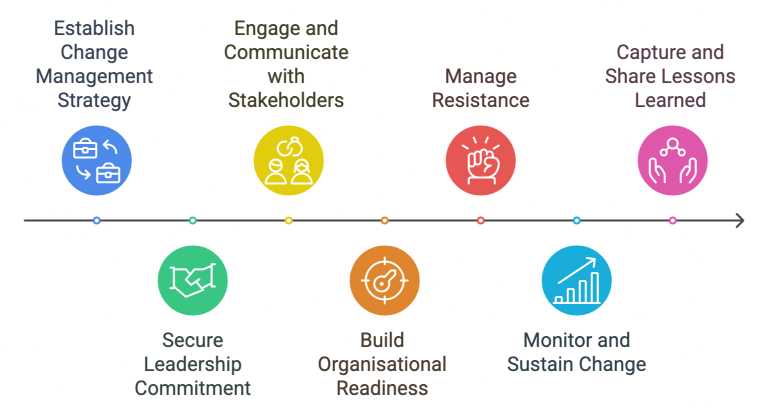
Here are the key steps to achieve your effective change management in GBS for your organisation:
1. Establish a Change Management Strategy
- Assess the Need for Change: Analyse the current state of the organisation and identify the drivers for change, such as operational inefficiencies, cost pressures, or changing customer demands.
- Define the Change Vision: Articulate a clear and compelling vision for your GBS transformation, outlining your desired future state and the benefits it will bring to the organisation.
- Develop a Comprehensive Change Management Plan: Create a detailed plan that outlines the specific steps, timelines, and resources required to implement your change effectively.
2. Secure Leadership Commitment and Sponsorship
- Gain Executive Buy-In: Secure the commitment and active involvement of senior leadership, as your support is crucial for driving the change initiative.
- Appoint Change Champions: Identify and empower change champions at all levels of your organisation to act as advocates and role models for your transformation.
3. Engage and Communicate with Stakeholders
- Identify Stakeholders: Conduct a comprehensive stakeholder analysis to understand the various groups affected by the GBS transformation, including employees, customers, and suppliers.
- Develop a Communication Plan: Create a communication strategy that addresses the needs and concerns of different stakeholder groups, using a variety of channels to ensure effective information sharing.
- Foster Transparency: Maintain open and transparent communication throughout the change process, providing regular updates and addressing any questions or concerns raised by stakeholders.
4. Build Organisational Readiness
- Assess Change Readiness: Evaluate your organisation’s current level of change readiness, identifying potential barriers and resistance to the transformation.
- Implement Change Enablers: Develop and deploy change enablers, such as training programs, job redesign, and organisational restructuring, to help your employees adapt to the new GBS model.
- Empower Employees: Encourage employee participation and feedback, and provide the necessary resources and support to help them navigate the change.
5. Manage Resistance and Overcome Barriers
- Identify and Address Resistance: Proactively identify sources of resistance and develop strategies to address them, such as addressing concerns, providing additional support, or adjusting your change approach.
- Overcome Organisational Inertia: Implement measures to overcome the natural tendency towards maintaining the status quo, such as setting clear goals, celebrating small wins, and recognising and rewarding change-oriented behaviours.
6. Monitor and Sustain the Change
- Establish Feedback Loops: Implement mechanisms for continuous feedback and monitoring, allowing your organisation to assess the progress and impact of the GBS transformation.
- Reinforce the Change: Continuously reinforce your change through ongoing communication, training, and recognition of successful change implementation.
- Adapt and Iterate: Continuously review and adjust your change management approach as needed, based on feedback and lessons learned, to ensure the sustainability of your GBS transformation.
7. Capture and Share Lessons Learned
- Document Best Practices: Capture and document the lessons learned throughout your change management process, including both successes and challenges.
- Share Knowledge: Disseminate the lessons learned and best practices across your organisation to inform future change initiatives and support continuous improvement.
Infuntainment can help your organisation establish a robust framework for performance measurement and continuous improvement within your Global Business Services. This strategic approach not only enhances operational efficiency but also fosters your culture of excellence, enabling organisations to adapt to changing market conditions and drive sustainable growth. Prioritising performance measurement and continuous improvement will ultimately lead to better service delivery and increased competitiveness in the global marketplace.
D. Performance Measurement and Continuous Improvement
To ensure that GBS operations remain effective, we implement robust performance measurement frameworks. We help you establish key performance indicators (KPIs) and metrics that align with your strategic goals. Our continuous improvement approach fosters a culture of ongoing assessment and adaptation, allowing your business/es to respond proactively to changing market conditions and internal challenges.
Implementing effective performance measurement and fostering a culture of continuous improvement are essential for maximising the effectiveness of Global Business Services (GBS).
Implementing effective performance measurement and fostering a culture of continuous improvement are vital for enhancing the efficiency and effectiveness of Global Business Services (GBS).
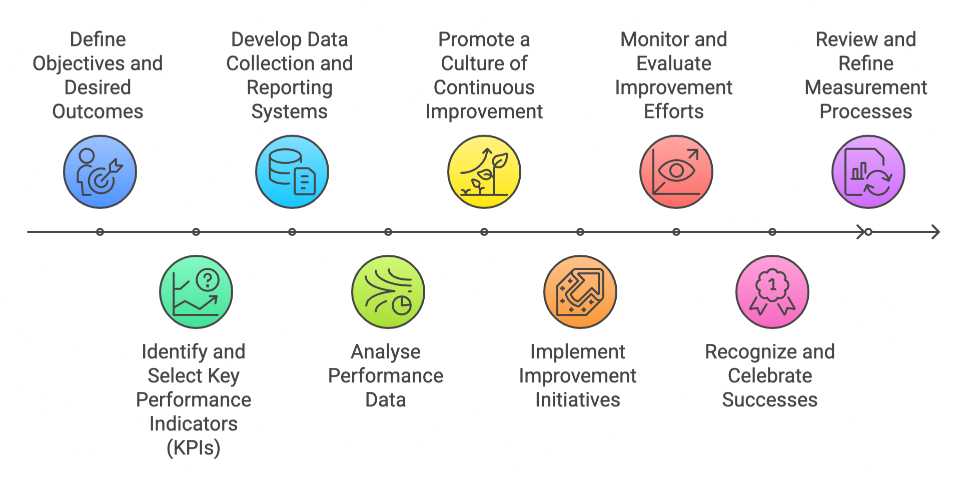
To effectively implement performance measurement and foster continuous improvement within Global Business Services (GBS), your organisation should follow these structured steps:
1. Define Objectives and Desired Outcomes
- Align with Business Goals: Ensure that your performance measurement objectives are closely aligned with your broader organisational goals and strategic objectives.
- Establish Clear Outcomes: Clearly define what successful performance looks like, including specific outcomes related to service quality, efficiency, cost savings, and customer satisfaction.
2. Identify and Select Key Performance Indicators (KPIs)
- Determine Relevant KPIs: Identify KPIs that will provide insight into performance relative to your defined objectives. Examples include service level agreements (SLAs), turnaround times, and client satisfaction scores.
- Involve Stakeholders: Engage your employees and stakeholders in the selection of KPIs to ensure they are meaningful and relevant to your roles.
3. Develop Data Collection and Reporting Systems
- Design Data Collection Processes: Create processes for collecting the necessary data to measure your identified KPIs. This may involve leveraging your existing software systems or implementing new tools.
- Implement Reporting Mechanisms: Establish reporting frameworks that deliver performance data regularly to relevant stakeholders. Dashboards and performance scorecards can enhance your visibility and understanding.
4. Analyse Performance Data
- Conduct Regular Analysis: Regularly analyse performance data to assess progress against KPIs. Use statistical methods and data visualisation tools to identify trends and areas for improvement.
- Identify Root Causes: Investigate any performance shortfalls to understand the underlying causes. This may involve conducting root cause analysis or process mapping to uncover inefficiencies.
5. Promote a Culture of Continuous Improvement
- Encourage Employee Participation: Foster an environment where employees are encouraged to contribute ideas for improvement. Implement suggestion programs or hold brainstorming sessions to gather input.
- Adopt Improvement Methodologies: Utilise improvement frameworks such as Lean, Six Sigma, or Kaizen to systematically approach process enhancements.
6. Implement Improvement Initiatives
- Prioritise Improvement Projects: Evaluate and prioritise potential improvement projects based on your expected impact and feasibility. Focus on initiatives that align with strategic goals.
- Develop Action Plans: Create detailed action plans for each improvement initiative, outlining specific steps, responsibilities, timelines, and resources required for implementation.
7. Monitor and Evaluate Improvement Efforts
- Track Progress: Monitor the implementation of improvement initiatives and track your impact on performance metrics. Use KPIs to assess whether the initiatives are delivering your desired results.
- Adjust as Necessary: Be prepared to make adjustments to improvement initiatives based on performance data and feedback. Flexibility and adaptability are key to sustaining improvement.
8. Recognise and Celebrate Successes
- Acknowledge Achievements: Celebrate milestones and successes related to performance improvement. Recognising contributions fosters motivation and reinforces a commitment to continuous improvement.
- Share Best Practices: Disseminate successful strategies and lessons learned across your organisation to encourage knowledge sharing and replication of effective practices.
9. Review and Refine Measurement Processes
- Conduct Periodic Reviews: Regularly review the performance measurement framework to ensure it remains relevant and effective. Assess whether the selected KPIs continue to align with your organisational goals.
• • Make Continuous Adjustments: Refine data collection processes, reporting mechanisms, and KPIs as needed based on evolving business needs and stakeholder feedback.
Implementing performance measurement and continuous improvement within Global Business Services is a dynamic and ongoing process. By following these steps, your organisation can enhance operational efficiency, improve service quality, and foster a culture of excellence. Prioritising these efforts will empower your organisation to adapt to changing demands and ensure sustainable growth in a competitive landscape.
E. Risk Management and Compliance
Navigating the complexities of global operations requires a keen understanding of regulatory environments and risk management. Our consultancy provides expertise in identifying potential risks and developing comprehensive compliance strategies. We help organisations mitigate operational risks while ensuring adherence to local and international regulations, allowing them to operate confidently in diverse markets.
Effective risk management and compliance are crucial for Global Business Services (GBS) to protect the organisation from potential threats and ensure adherence to regulations.

Here are the key steps to achieve robust risk management and compliance:
1. Establish a Risk Management Framework
- Define Risk Management Objectives: Clearly outline the objectives of the risk management process, ensuring alignment with your organisation’s strategic goals and compliance requirements.
- Develop a Risk Management Policy: Create a formal policy that establishes the principles, processes, and responsibilities for managing risks within your GBS framework.
2. Identify Risks
- Conduct Risk Assessments: Perform comprehensive risk assessments to identify potential risks that could impact your GBS operations. This includes operational, financial, regulatory, and reputational risks.
- Engage Stakeholders: Involve key stakeholders in the risk identification process to gather diverse perspectives and insights on potential risks.
3. Analyse and Evaluate Risks
- Assess Risk Impact and Likelihood: Analyse identified risks by evaluating your potential impact on your organisation and the likelihood of occurrence. This helps prioritise risks based on your significance.
- Use Risk Assessment Tools: Utilise tools and methodologies such as risk matrices or heat maps to visually represent and categorise risks based on your severity.
4. Develop Risk Mitigation Strategies
- Create Risk Response Plans: For each identified risk, develop response plans outlining strategies to mitigate, transfer, accept, or avoid the risk.
- Assign Responsibilities: Designate risk owners responsible for implementing and monitoring the effectiveness of the risk mitigation strategies.
5. Implement Compliance Programs
- Understand Regulatory Requirements: Stay informed about relevant regulations and compliance requirements applicable to your GBS operations. This includes industry standards, data protection laws, and financial regulations.
- Develop Compliance Policies: Create and implement compliance policies and procedures that address regulatory requirements and outline expectations for employee behaviour.
6. Provide Training and Awareness
- Conduct Training Programs: Develop training programs to educate your employees on risk management practices, compliance requirements, and your roles in the process.
- Promote a Risk-Aware Culture: Foster a culture of risk awareness and compliance throughout your organisation by encouraging open discussions about risks and ethical behaviours.
7. Monitor and Review Risks and Compliance
- Establish Monitoring Mechanisms: Implement processes to continuously monitor the effectiveness of risk management strategies and compliance programs. This may include regular audits and performance reviews.
- Conduct Regular Reviews: Periodically review and update risk assessments, response plans, and compliance policies to ensure they remain relevant and effective in addressing emerging risks and regulatory changes.
8. Report and Communicate
- Develop Reporting Frameworks: Create reporting structures that facilitate effective communication of risk and compliance status to your key stakeholders, including senior management and the board.
- Encourage Transparency: Promote a culture of transparency where your employees feel comfortable reporting risks or compliance issues without fear of reprisal.
9. Review and Enhance the Risk Management Process
- Evaluate Process Effectiveness: Regularly assess the effectiveness of your risk management and compliance processes. Gather feedback from your stakeholders to identify areas for improvement.
- • • Adapt to Changes: Be prepared to adapt your risk management strategies and compliance programmes based on changes in the regulatory environment, business operations, or emerging risks.
By following these steps we can help your organisation establish a comprehensive risk management and compliance framework within your Global Business Services. This proactive approach not only minimises your potential risks but also ensures adherence to your regulatory requirements, enhancing your overall organisational resilience and integrity. Prioritising your risk management and compliance will ultimately contribute to your sustainable business success and stakeholder trust.
F. Customised Solutions
Every organisation is unique, and so are its operational challenges. We believe in providing customised solutions tailored to your specific needs. Our team collaborates closely with stakeholders to understand your objectives and design GBS services that align with your vision, ensuring a personalised approach that drives real results.
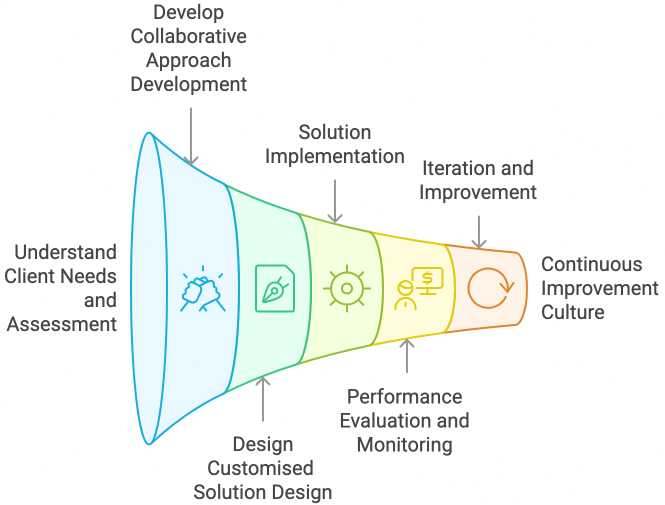
Creating customised solutions within Global Business Services (GBS) involves understanding your specific needs and tailoring services accordingly. Here are the key steps to achieve this:
1. Understand Client Needs and Requirements
- Conduct Needs Assessments: Engage with your teams to gather detailed information about your specific needs, challenges, and objectives. This can be done through surveys, interviews, or workshops.
- Analyse Business Context: Understand the your industry, market position, and operational context to tailor solutions that align with your strategic goals.
2. Develop a Collaborative Approach
- Involve Stakeholders: Collaborate with your key stakeholders from both the GBS team and the your organisation to ensure that all perspectives are considered in the solution design.
- Foster Open Communication: Maintain transparent communication throughout the process to build trust and ensure alignment on expectations and deliverables.
3. Design Customised Solutions
- Leverage Data and Insights: Utilise data-driven insights to inform the design of your customised solutions. This may involve analysing your existing processes, performance metrics, and industry benchmarks.
- Create Prototypes or Mockups: Develop prototypes or mockups of your proposed solutions to visualise how they will function and gather feedback from your stakeholders.
4. Implement the Customised Solutions
- Develop an Implementation Plan: Create a detailed plan outlining the steps, timelines, and resources required for implementing your customised solutions.
- Assign Responsibilities: Clearly define roles and responsibilities for your team members involved in the implementation process to ensure accountability.
5. Monitor and Evaluate Performance
- Establish Performance Metrics: Define key performance indicators (KPIs) to measure the effectiveness of your customised solutions. This will help you assess whether the solutions meet the your needs.
- Collect Feedback: Regularly gather feedback from your teams and your stakeholders during and after implementation to evaluate the performance of your solutions.
6. Iterate and Improve
- Analyse Performance Data: Continuously analyse performance data to identify areas for improvement. This may involve using tools like dashboards or balanced scorecards to track progress.
- Make Adjustments: Be prepared to make iterative adjustments to your solutions based on feedback and performance analysis to enhance effectiveness and your satisfaction.
7. Foster a Culture of Continuous Improvement
- Encourage Innovation: Promote a culture that encourages innovation and the exploration of new ideas for enhancing customised solutions.
• • Share Best Practices: Document and share successful strategies and lessons learned from your implementation of customised solutions to inform future projects and foster organisational learning.
By following these steps, your organisation can effectively develop and implement customised solutions within your Global Business Services framework. This tailored approach not only addresses specific business needs but also enhances overall service delivery and client satisfaction. Emphasising collaboration, data-driven decision-making, and continuous improvement will ensure that your GBS remains responsive and adaptable in a dynamic business environment.

